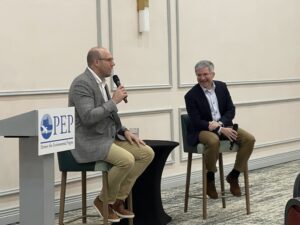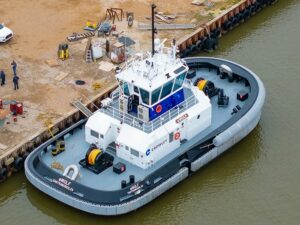Challenges and Triumphs: Electrifying the Future of Tugboat Design
During PEP’s March Member Breakfast, our speakers discussed the current
 During PEP’s March Member Breakfast, our speakers discussed the current and future state of the marine industry. Garrett Rice, President of Master Boat Builders, and Richard Tremayne,
During PEP’s March Member Breakfast, our speakers discussed the current and future state of the marine industry. Garrett Rice, President of Master Boat Builders, and Richard Tremayne,
General Manager, Marine with 27 years of experience at Thompson Marine, shared their insights on the evolution toward hybrid and electric tugs. The collaboration between the two companies, extending over three-and-a-half decades, has resulted in innovation in the waters of the Bayou.
Tugboats have relied heavily on diesel fuel for years, carrying thousands of gallons on board. Recognizing the surge in demand for sustainability, pivotal players like the International Maritime Organization (IMO) have laid out stringent emission standards. With smaller vessels like tugboats under the lens, Master Boat Builders, Thompson Marine, Berg Propulsion, and architects Robert Allan, Ltd. pioneered a hybrid design for a client.
Emitting carbon dioxide is not a badge any industry wishes to wear, so their clients are increasingly interested in pushing Master Boat Builders and Thompson Marine into hybrid tug design. Maneuverability enhancement is an attractive by-product of these endeavors.
 Introducing batteries into the power mix was not always practical. These partners developed a ground-breaking hybrid system pairing diesel power with a 500-kilowatt electric motor. This system significantly reduced running times for the hefty diesel engines and consequently saved on maintenance costs.
Introducing batteries into the power mix was not always practical. These partners developed a ground-breaking hybrid system pairing diesel power with a 500-kilowatt electric motor. This system significantly reduced running times for the hefty diesel engines and consequently saved on maintenance costs.
The real game-changer was a client’s challenge to Master Boat Builders in 2020 to build the first all-electric, ship assist harbor tugboat in the USA. Taking the helm of progress, partners in the project built eWolf, the first electric tug in the U.S. This 79-foot sea marvel contained 1,100 batteries weighing 60 tons and symbolically carried the weight of the industry’s eco-conscious shift.
Building the vessel took two and a half years, slightly longer than a conventional tug, reflecting the intricacies of fitting an advanced electric setup in a confined space. Yet, upon completion, the reduction in carbon emissions was astronomical—100%! Due to the current short operational spans of the electric tug, the innovation is not appropriate for every port.
“The tug, constructed by Master Boat Builders at its shipyard in Coden, Ala., will generate 178 tons less of nitrogen oxide (NOx), 2.5 tons less of diesel particulate matter and 3,100 metric tons less of carbon dioxide (CO2) over the first 10 years of its operations – the equivalent of removing 350,000 gallons of gas from use, according to EPA calculations. The vessel uses ABB’s innovative, integrated electrical propulsion system.” You can learn more about the eWolf vessel in this article: First fully electric tugboat in U.S. delivered to Crowley.
The quest for sustainable maritime solutions doesn’t anchor on electric power. The teams continue to evolve design enhancements aiming for elongated battery power and negligible emissions. Innovations like replacing generator sets with batteries illuminate a path where tugs can harness electricity shoreside and reserve diesel for open water.
The challenge is a monetary one as well. Diesel maintenance savings do not fully compensate for the capital cost of batteries. Nonetheless, with federal regulations moving in favor of green innovations, grants and funding might soon tip the scales, paving the way for even more eco-friendlier vessels to move into production.
The marine industry hasn’t placed its hopes on electric power alone. Other fuels—methanol, hydrogen, and ammonia—are on the radar, but they still require elaborate experimentation. For now, renewable diesel appears most worthy, capable of cutting carbon emissions by 75%.
Despite the promising advances in technology, the tides of change flow slowly. The industry’s venerable vessels, with lifespans stretching to half a century, won’t retire their diesel engines overnight. We’re witnessing a balancing act, a pursuit of progress tinged with practicalities of cost and feasibility.
Notably, companies like Maersk, wielding substantial influence and resources, are investing in electric and methanol-powered ships, expecting proportional growth in harbor facilities and ports to support their electric fleets.
Rice and Tremayne’s insights illuminate a trailblazing path for the marine industry, marked by energy innovation and ecological responsibility —a cleaner, greener chapter on the horizon.
During PEP’s March Member Breakfast, our speakers discussed the current
Another PEP member is in the news for their work
Electric aviation is becoming a reality in Alabama as the
The PEP March newsletter is out! Spring in Mobile is
Partners for Environmental Progress (PEP) is proud to announce the
Ransom Recycling of Chickasaw has announced it will soon be the